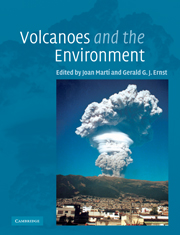Book contents
- Frontmatter
- Contents
- List of contributors
- Preface
- Acknowledgments
- Chapter 1 Understanding the physical behavior of volcanoes
- Chapter 2 Volcano hazards
- Chapter 3 Anticipating volcanic eruptions
- Chapter 4 Volcanoes and the geological cycle
- Chapter 5 Effects of volcanic eruptions on the atmosphere and climate
- Chapter 6 Volcanoes, hydrothermal venting, and the origin of life
- Chapter 7 Volcanism and mass extinctions
- Chapter 8 Effects of modern volcanic eruptions on vegetation
- Chapter 9 Animals and volcanoes: survival and revival
- Chapter 10 Human impacts of volcanoes
- Chapter 11 Volcanoes, geothermal energy, and the environment
- Chapter 12 Volcano-hosted ore deposits
- Chapter 13 Industrial uses of volcanic materials
- Chapter 14 Volcanoes, society, and culture
- Chapter 15 Volcanoes and the economy
- Index
- References
Chapter 5 - Effects of volcanic eruptions on the atmosphere and climate
Published online by Cambridge University Press: 14 November 2009
- Frontmatter
- Contents
- List of contributors
- Preface
- Acknowledgments
- Chapter 1 Understanding the physical behavior of volcanoes
- Chapter 2 Volcano hazards
- Chapter 3 Anticipating volcanic eruptions
- Chapter 4 Volcanoes and the geological cycle
- Chapter 5 Effects of volcanic eruptions on the atmosphere and climate
- Chapter 6 Volcanoes, hydrothermal venting, and the origin of life
- Chapter 7 Volcanism and mass extinctions
- Chapter 8 Effects of modern volcanic eruptions on vegetation
- Chapter 9 Animals and volcanoes: survival and revival
- Chapter 10 Human impacts of volcanoes
- Chapter 11 Volcanoes, geothermal energy, and the environment
- Chapter 12 Volcano-hosted ore deposits
- Chapter 13 Industrial uses of volcanic materials
- Chapter 14 Volcanoes, society, and culture
- Chapter 15 Volcanoes and the economy
- Index
- References
Summary
The bright sun was extinguish'd and the stars
Did wander darkling in the eternal space,
Rayless, and pathless, and the icy earth
Swung blind and blackening in the moonless air;
Morn came and went – and came, and brought no day …
A section from “Darkness” by Lord Byron, written in June 1816 on the shores of Lake Geneva in the midst of the “Year without a Summer,” 14 months after the great eruption of the volcano Tambora in Indonesia.Introduction
Interest in the effects of volcanic activity on atmospheric phenomena, including the importance of volcanism in moderating climate and weather, has a long but patchy history, with the earliest recognition of a connection stretching back to classical times (Forsyth, 1988). The modern era of description began with the flood lava eruption from the Lakagígar (Laki) fissure in Iceland. Benjamin Franklin is usually attributed with being the first to make the connection between reports of an eruption in Iceland and an appalling “dry fog” (a sulfuric acid aerosol cloud) that hung over Europe in the summer of 1783 (Franklin, 1784; see also Thordarson and Self, 2003). From this point on, the role of volcanism in influencing and moderating our climate and weather has been a topic of debate (Self and Rampino, 1988; Robock, 2000) culminating in the past few decades with the need for a detailed understanding of natural influences on, and variability in, our atmosphere.
- Type
- Chapter
- Information
- Volcanoes and the Environment , pp. 152 - 174Publisher: Cambridge University PressPrint publication year: 2005
References
- 6
- Cited by

